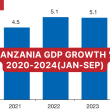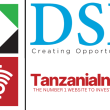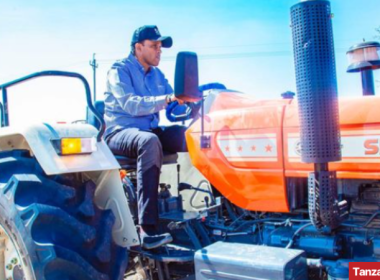Cotton
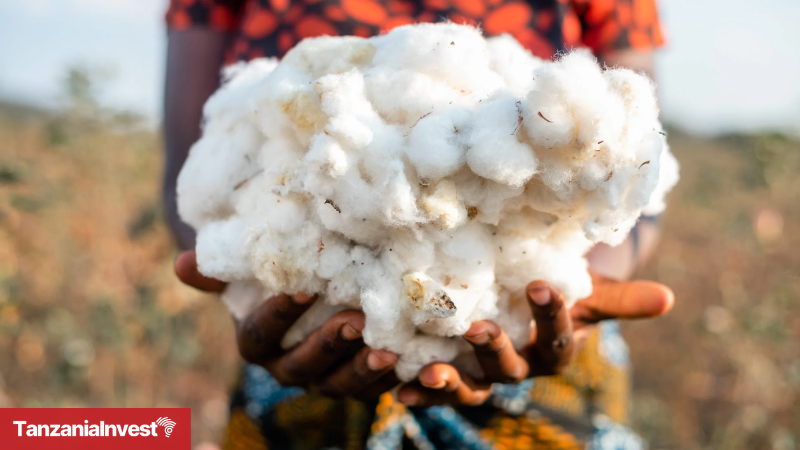
After the independence of Tanzania in 1961, cotton cooperatives were promoted but later dissolved due to inefficiencies. This led to the establishment of the Tanzania Cotton Authority (TCA) in 1976, which later transitioned to the Tanzania Cotton Board (TCB).
The key cotton-producing regions include Simiyu, Mwanza, Tanga, Singida, Geita, Tabora, Mara, Kigoma, Katavi, and Kagera.
According to Minister Bashe’s budget speech for 2024/2025, Tanzania’s cotton production has reached 282,510 tons in 2023/2024 which is 80.7% of the target to produce 350,000 tons in the same year: The cotton production reached 174,486 tons in 2022/2023, and 144,792 in 2021/2022.
Cotton productivity has increased from 0.6 tons per hectare to 1.34 tons per hectare in 2023/2024, which is 45% of the potential yield of producing 3 tons per hectare.
According to the International Cotton Advisory Committee’s 2022/23 report, Tanzania is a significant exporter of medium staple (American upland) cotton varieties, and its major lint export destinations are Pakistan, Bangladesh, India, Vietnam, and Thailand.
In the 2018/19 season, Tanzania exported 499,248 bales of cotton lint valued at USD 159.1 million. By the 2022/23 season, cotton exports decreased to 283,694 bales while revenues increased to USD 172.8 million representing a 43% loss in export volume and an 8.6% increase in value.
Although Pakistan didn’t import cotton in 2018/19, in the 2019/20 season, it imported 199,266 bales of Tanzanian cotton lint, valued at approximately USD 63.5 million, representing 40% of all volumes exported (499,248 bales). By the 2022/23 season, Pakistan’s imports had decreased to 93,253 bales, valued at around USD 49.6 million, representing a 28 % decrease in value and 33% of Tanzania’s overall cotton lint exports that year (283,694 bales).
Bangladesh imported 40,352 bales of Tanzanian cotton lint in 2018/19, valued at roughly USD 14.1 million. By 2022/23, Bangladesh’s imports had decreased by 19% in volumes to 32,664 bales and had increased by 35% in value to USD 19.1 million.
India started the 2018/19 season with imports of 49,317 bales, valued at approximately USD 16.9 million. By 2022/23, India’s imports had significantly risen to 62,736 bales which is a 27% increase, valued at around USD 36.5 million, a 116% increase.
Vietnam’s imports of Tanzanian cotton lint in 2018/19 were 1,790 bales, valued at about USD 760,000. By 2022/23, Vietnam’s imports had grown to 5,920 bales 230% increase, valued at approximately USD 2.9 million a 281% increase.
Thailand imported 17,202 bales of Tanzanian cotton lint in 2018/19, valued at around USD 5.7 million. By 2022/23, Thailand’s imports had decreased to 2,330 bales, valued at about USD 1.2 million.
Tanzania also exports cotton lint to Belgium, China, France, Germany, Indonesia, Italy, Japan, Kenya, Malaysia, Mauritius, Mozambique, Morocco, Netherlands, Portugal, Singapore, Switzerland, Swaziland, Taiwan, Turkey, United Arab Emirates (UAE), and Rwanda.
In the 2015/16 marketing season, Tanzania’s cotton seed production was 202,264 metric tons. This increased to 280,000 metric tons by the 2023/24 season.
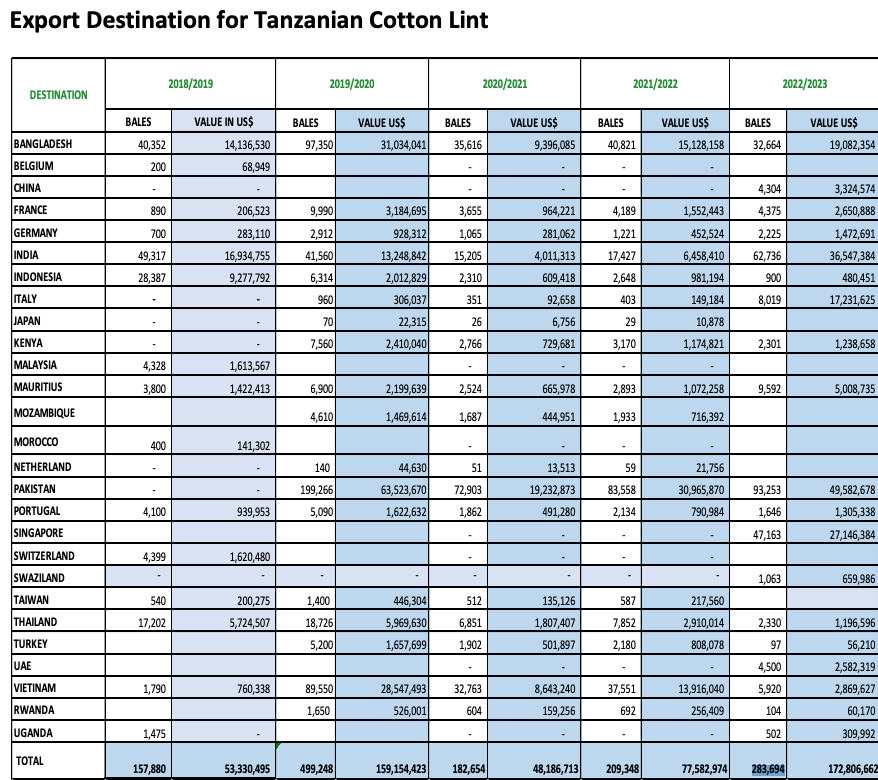
Tanzania produces organic cotton that is considered highly authentic due to the non-use of Genetically Manipulated Organisms (GMOs) and minimal reliance on industrial fertilizers and pesticides.
In the 2023/24 season, the price for cotton lint was USD 0.75 per pound, while the price for cotton seed was TZS 800 per kilogram.
The International Cotton Advisory Committee’s Report explains that the Tanzanian cotton sector faces significant farm and textile challenges.
At the farm level, low productivity is a major issue, which results from dependence on rainfall, limited inputs, poor mechanization, fragmented land, and insufficient financial credit.
Fluctuating farm gate prices and volatility in global cotton prices and exchange rates add further financial risks.
Tanzania Cotton Board (TCB)
The Tanzania Cotton Board (TCB) is the Government’s institution responsible for coordinating and managing cotton farming procedures and regulations in all regions of the country.
The Board’s activities align with the National Agricultural Sector Development Program (ASDP) II and the Tanzania National Development Plan (TNDP).
Currently, TCB is implementing its Fourth Five-Year Strategic Plan (2021/22 – 2025/26), which focuses on six key strategies: addressing cross-cutting issues, enhancing sustainable production and productivity, improving cotton quality and cleanliness, promoting value addition at the Agriculture Marketing Cooperative Society (AMCOS) which provides for the local purchase of agricultural input supplies and helps the farmer to market their crops level, strengthening the Board’s operational capacity, and supporting stakeholders.
The implementation of the strategic plan has led to notable achievements including the revival of the cotton seed multiplication system, enabling the production and distribution of certified seed (UMK08) from the Ukiriguru Cotton Research Centre to disease-free regions.
Additionally, cotton production increased with the percentage of Gaby and above grade lint improving from 11.64% in the 2020/21 season to 26.81% in 2021/22.
The Board has also successfully implemented new planting practices, raising productivity from 180 kilograms per acre to 500 kilograms per acre.
Through TCB, the Ministry of Agriculture has continued to strengthen cotton production by distributing in 2023/2024, 24,318 tons of cotton seeds, which is 110% of the target to distribute 22,146 tons to farmers in all cotton-growing regions. Additionally, 16,500,000 bottles/packets of pesticides have been purchased, with 7,000,000 of them already distributed to farmers, and distribution is ongoing.
Challenges remain to the cotton production of Tanzania. These include bad weather conditions, infestation of insects, and financial constraints.
Nonetheless, the Ministry, through TCB, plans to increase cotton production from 282,510 tons in the 2023/2024 season to 500,000 tons in the 2024/2025 season and improve the quality of cotton from 44.3% to 75% in higher grades.
This goal will be achieved by purchasing, processing, and distributing 28,000 tons of quality cotton seeds, 7,000,000 bottles (acre packs), and 100,000 sprayers to cotton farmers.
Last Updated: 16th September 2024



